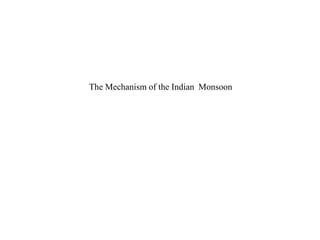The mechanism of monsoons
•Download as PPTX, PDF•
7 likes•10,501 views
Report
Share
Report
Share

More Related Content
What's hot
What's hot (20)
Presentation on horizontal differences of Temperature

Presentation on horizontal differences of Temperature
Viewers also liked
Sea Breeze and Land Breeze, Weather and Climate Unit, Earth Science PowerPoint

Sea Breeze and Land Breeze, Weather and Climate Unit, Earth Science PowerPointwww.sciencepowerpoint.com
Viewers also liked (12)
Sea Breeze and Land Breeze, Weather and Climate Unit, Earth Science PowerPoint

Sea Breeze and Land Breeze, Weather and Climate Unit, Earth Science PowerPoint
Similar to The mechanism of monsoons
Similar to The mechanism of monsoons (20)
Recently uploaded
Recently uploaded (20)
Automating Google Workspace (GWS) & more with Apps Script

Automating Google Workspace (GWS) & more with Apps Script
Scaling API-first – The story of a global engineering organization

Scaling API-first – The story of a global engineering organization
The 7 Things I Know About Cyber Security After 25 Years | April 2024

The 7 Things I Know About Cyber Security After 25 Years | April 2024
Raspberry Pi 5: Challenges and Solutions in Bringing up an OpenGL/Vulkan Driv...

Raspberry Pi 5: Challenges and Solutions in Bringing up an OpenGL/Vulkan Driv...
2024: Domino Containers - The Next Step. News from the Domino Container commu...

2024: Domino Containers - The Next Step. News from the Domino Container commu...
Exploring the Future Potential of AI-Enabled Smartphone Processors

Exploring the Future Potential of AI-Enabled Smartphone Processors
[2024]Digital Global Overview Report 2024 Meltwater.pdf![[2024]Digital Global Overview Report 2024 Meltwater.pdf](data:image/gif;base64,R0lGODlhAQABAIAAAAAAAP///yH5BAEAAAAALAAAAAABAAEAAAIBRAA7)
![[2024]Digital Global Overview Report 2024 Meltwater.pdf](data:image/gif;base64,R0lGODlhAQABAIAAAAAAAP///yH5BAEAAAAALAAAAAABAAEAAAIBRAA7)
[2024]Digital Global Overview Report 2024 Meltwater.pdf
Bajaj Allianz Life Insurance Company - Insurer Innovation Award 2024

Bajaj Allianz Life Insurance Company - Insurer Innovation Award 2024
Breaking the Kubernetes Kill Chain: Host Path Mount

Breaking the Kubernetes Kill Chain: Host Path Mount
Handwritten Text Recognition for manuscripts and early printed texts

Handwritten Text Recognition for manuscripts and early printed texts
Apidays Singapore 2024 - Building Digital Trust in a Digital Economy by Veron...

Apidays Singapore 2024 - Building Digital Trust in a Digital Economy by Veron...
08448380779 Call Girls In Friends Colony Women Seeking Men

08448380779 Call Girls In Friends Colony Women Seeking Men
Presentation on how to chat with PDF using ChatGPT code interpreter

Presentation on how to chat with PDF using ChatGPT code interpreter
The mechanism of monsoons
- 1. The Mechanism of the Indian Monsoon
- 2. • The monsoons are the seasonal winds that blow from sea to land for two to five months in the tropical lands. • It is the complete replacement of the dry hot air by the equatorial maritime air up to an altitude of three to five kilometers over the land and water surface. • Meteorologists have found a sea-saw kind of relationship between the meteorological changes over the Pacific and Indian Oceans. Whenever the surface pressure is high in the sub-tropical region of the Pacific Ocean in the northern hemisphere, the pressure over the southern part of the Indian Ocean tends to be low and vice versa
- 3. • Meteorologists have found a sea-saw kind of relationship between the meteorological changes over the Pacific and Indian Oceans. Whenever the surface pressure is high in the sub-tropical region of the Pacific Ocean in the northern hemisphere, the pressure over the southern part of the Indian Ocean tends to be low and vice versa. This causes the shifting of the winds across the equator in different seasons. • This shifting of the winds across the equator is called the ‘Southern Oscillation’
- 4. • In the summer season of Northern Hemisphere the pressure over the Indian Ocean is low compared to the pressure over the Pacific Ocean in the Southern Hemisphere. • Thus the winds from the Pacific Ocean blow towards the Indian Ocean. • In south of the Equator the direction of the wind is from south east to north west but as it crosses the Equator it becomes south west to north east.
- 5. • This change in direction occurs due to the rotation of the earth ie; the Coriolis force. • Ferrel’s had stated that all the winds in the Northern Hemisphere get deflected to their right and all the winds in the Southern Hemisphere get deflected to their left. • Since the monsoon winds enter India from the south west direction we call it the South West Monsoon.
- 6. WIND DIRECTION DURING THE MONSOON SEASON
